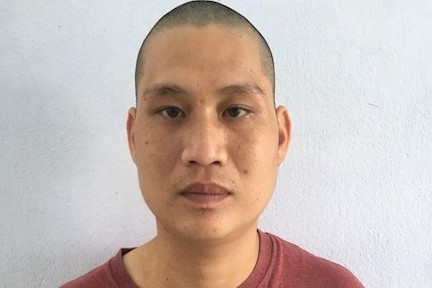Two ‘devils’ keep women in a prison in the middle of the forest
AmericaFrom a petty theft, the police uncover the shocking crimes of two serial killers but encounter many obstacles when bringing the treacherous criminal to court.
On June 2, 1985, the owner of a hardware store in San Francisco reported that an Asian man took $75 worth of pliers without paying. When the police arrived, the man was gone. Police found the pliers in the trunk of a car parked at the entrance. The owner of the car, Leonard Lake, said that the person who stole the pliers was his friend, Ngo Chi Dat, and offered to help him pay.
But Lake was detained by police because he found a pistol with a silencer in the trunk. Lake’s driver’s license was in the name of Robin Stapley, while the car belonged to Paul Cosner.
At the police station, Lake was honest, asking for a glass of water, a piece of paper and a pen to write the statement. After giving Lake things, the police officer in charge of the interrogation left the restroom. Returning a few minutes later, he found Lake lying on the floor, foaming at the mouth and shaking uncontrollably. Lake died after being taken to the emergency room, the doctor concluded that it was cyanide poisoning.
Investigating with Robin Stapley’s name on his driver’s license, police discovered that Robin disappeared a few weeks ago, the car owner Paul Costner also disappeared a year ago.
There were a lot of credit cards not owned by Lake in the car, lots of bullets and bullet holes. The test equipment showed that there were many blood stains on the car, proving that there was a murder.
Police discovered an electric bill with Claralyn Balasz’s name on it, which was located in a remote area at the foot of the Sierra Nevada mountains in Wilseyville, California.
Lynn is Lake’s ex-wife. She said the house on the bill belonged to her father, and Lake had always lived there. Lynn then took the police to a remote cabin house surrounded by dense, sparsely populated forest. The house area has a locked iron gate and a sign prohibiting outsiders from entering.

Lake and Dat abducted, tortured and murdered the victims at the cabin house in the middle of the forest, in 1984-1985. Photo: allthatsinteresting
Inside the house, the four corners of the bed were tied with a belt and fixed with a wooden pole, on the bed was bloodstained, there were some women’s underwear, there were bullet holes on the wall, a camera pointed directly at the bed.
Police think of a case where someone posted a rental camera in the newspaper, then the family of three disappeared. Comparing the serial number, this camera is the same one advertised in the newspaper.
According to Lynn, Lake was afraid of war, so he built behind the cabin a shelter to store food, always locking the door. When the police entered, it was like a torture chamber with handcuffs, shackles, saws, whips and other tools. On the wall are pictures of naked girls. Various weapons, guns, magazines and books on how to make chemical weapons are on the bookshelf. Behind the cabinet is a hidden “cell”, many rules are written on paper such as: be ready to obey; not allowed to talk to anyone without orders; must keep silent; never look the owner in the eye…
There is also a 250-page diary by Lake, which records that he would keep women in “prison”, turning them into sex slaves.
Police suspected the women in the photo had all been killed and began digging around the house. They found a large number of bone fragments, totaling more than 20 kg, thereby identifying at least 11 victims. However, an envelope containing the missing person’s identification card suggests the total number of victims could be as high as 25.
Police also unearthed a plastic container containing two videotapes. In it, a woman was tied to a chair and brutally tortured. The two evildoers in the video are Lake and Ngo Chi Dat.
Lake committed suicide, the police immediately put all their efforts to arrest Dat.

Lake committed suicide when arrested in 1985, and Dat was sentenced to death. Photo: AP
Ngo Chi Dat, English name is Charles Ng, was born in 1960 in a wealthy family in Hong Kong. Since childhood, Dat was severely educated by his father with whips, always had a rebellious mentality and was forced to drop out of school many times.
After being arrested for theft at the age of 15, his father sent Dat to England to study boarding but not long after he was kicked out for stealing from friends. In 1978, Dat came to America to attend Notre Dame School in California. After a semester, he dropped out of school, constantly got in trouble for driving, causing an accident and then running away, making fake records to join the Marines to avoid prosecution, stealing military weapons. Dat escaped from prison in 1980, met and became friends with Lake.
In 1982, police raided the couple’s mobile home, found a large amount of illegal weapons and explosives, and arrested them both. Lake was released on bail, then fled to his wife’s cabin home. Dat was taken to a military court, convicted of theft and desertion. Freed after 18 months, Dat immediately went to find Lake, and committed crimes together in the “prison” in the middle of the forest. They trick their victims into their homes, kill men, and torture women to death.
While being hunted around the world, Dat fled to a remote park in Calgary, Canada, setting up camp as a hideout. A child accidentally discovered the camp, but when he led the police to come, Dat ran away.
On July 6, 1985, Dat went to a department store, stole a can of salmon with itchy hands, and was discovered by a security guard. During the struggle, Dat pulled out a gun and shot the guard. He revealed his identity and was quickly arrested by the local police.
The US police want Dat to be extradited to the US immediately. But according to Canadian law, Dat also committed crimes here, so he must be tried and served a sentence in Canada before he can be extradited to the US. Dat was sentenced to four and a half years in prison by the Canadian side for theft, armed assault and possession of a firearm.
After reaching the end of his prison term, the US police continued to make extradition requests but were refused. Canada abolished the death penalty in 1976, except for some military crimes. Under Canadian law, it is illegal for an inmate to be extradited from Canada to another country to be sentenced to death. Dat is a serial killer in the US, will definitely be sentenced to death, so the Canadian side does not agree to hand over the person.
After a long controversy, in September 1991, the Supreme Court of Canada agreed to extradite Dat to the US.
While serving his sentence, Dat studied American law, trying to find loopholes to delay trial or avoid crimes.
Returning to the US, Dat was held in Sacramento prison while awaiting trial. Charged with 12 counts of murder by the prosecutor, Dat began to use his legal knowledge to delay the trial.
Dat first filed a complaint that prison food was cold and unappetizing, and then said he had been discriminated against. In fact, because of Dat’s danger and heard that someone was about to kill him, the prison built a separate iron cage for Dat. After the complaint, the prison had to remove the cage and improve the quality of the food.
Dat again said that he suffered from motion sickness, having to take anti-sickness medicine while driving in the car every time he was interrogated made his thinking and psychological state confused, not suitable for court.
After that, he repeatedly fired lawyers, calling them incompetent, even the court had to change several judges because of his complaints.
After all the little things were worked out, Dat said 98% of the people in Calaveras County knew about the case, most believed he was guilty, this is clearly subjective bias and it would be unfair to go to trial. here. So the venue for the trial was moved to Orange County.
Dat’s trial began in October 1998. The case file is up to 350 cases with 100,000 pages and weighs 6 tons. There were 75 witnesses, but no one witnessed Dat commit the murder, so he blamed Lake entirely, saying he was forced. But the image in a tape shows that Dat actively cut the victim’s clothes, threatened her, Lake did not order him.
In February 1999, 12 jurors unanimously held that Dat was responsible for 11 murders. In the end, Dat was sentenced to death.
The prosecution of Dat cost California about $20 million, making it the most expensive trial in state history at the time.
As of November 2021, Dat is still being held at San Quentin prison because California has not executed any prisoners since 2006.
Tue Anh (According to Toutiao, Crime&investigation, Murderpedia)
at Blogtuan.info – Source: vnexpress.net – Read the original article here



